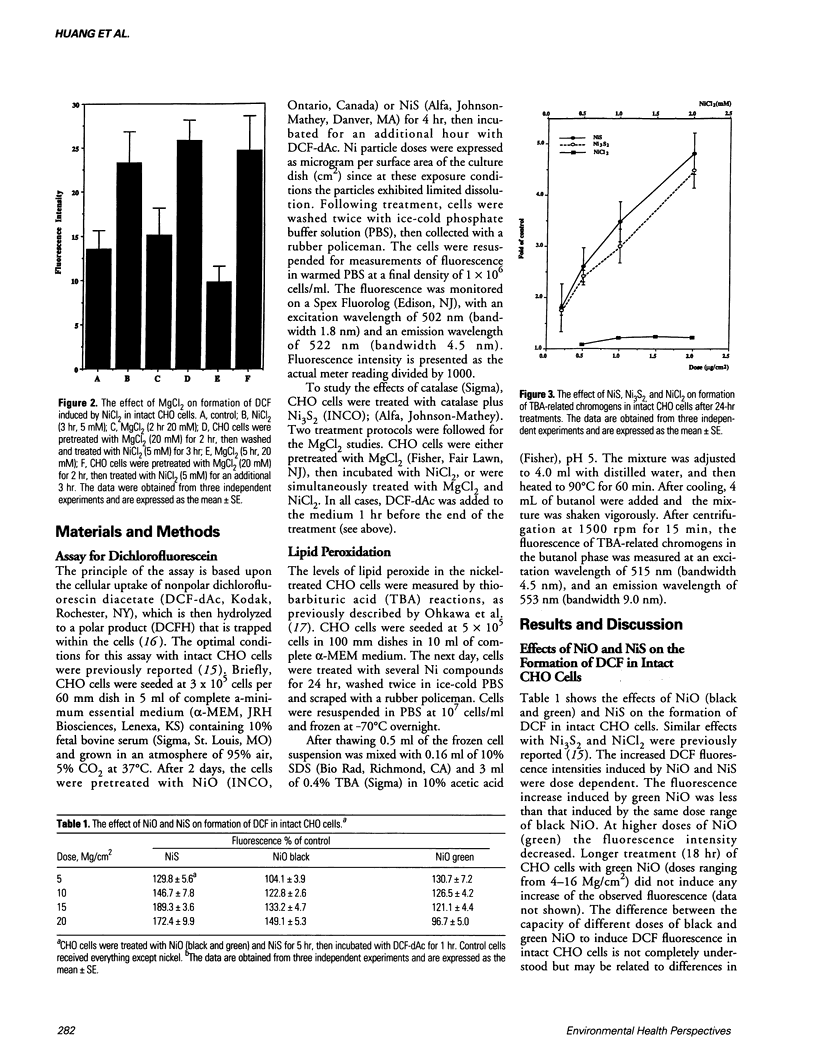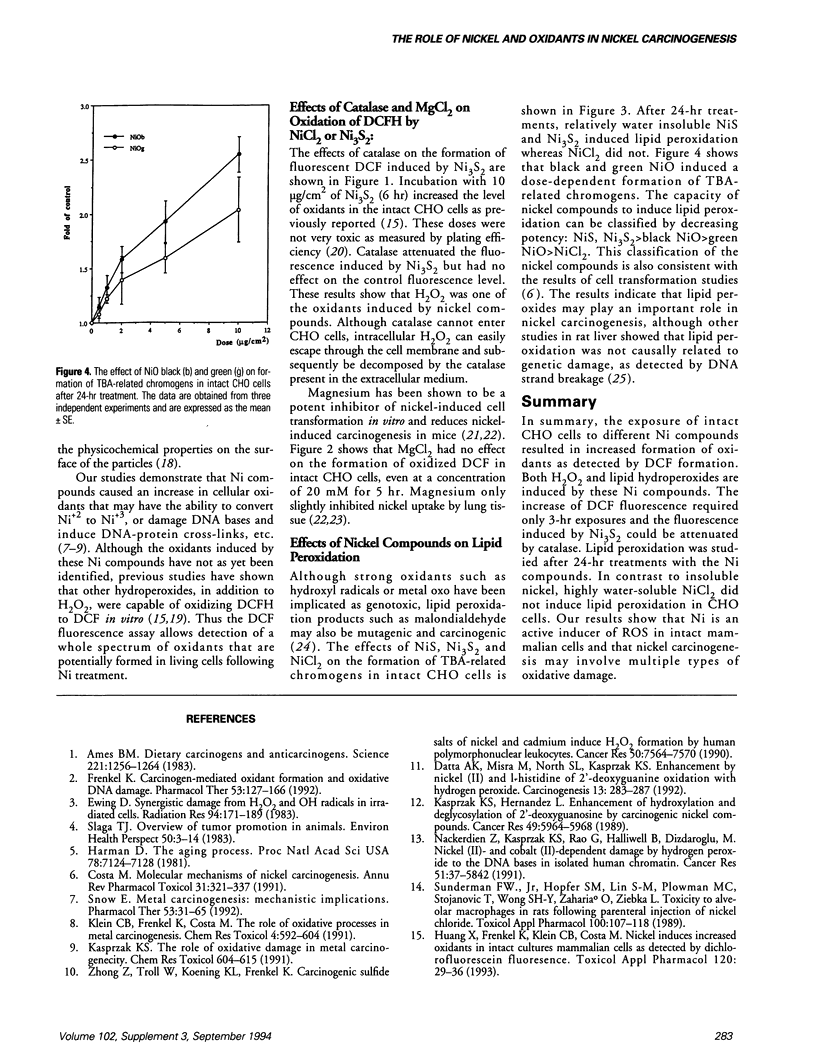Abstract
Increasing evidence demonstrates the reactive oxygen species (ROS) are implicated in metal carcinogenesis. Exposure of cultured Chinese hamster ovary (CHO) cells to several nickel compounds, i.e. NiS, Ni3S2, NiO (black and green), and NiCl2 has been shown to increase oxidation of 2',7-dichlorofluorescein to the fluorescent 2',7-dichlorofluorescein (DCF), suggesting that nickel compounds increased the concentration of oxidants in CHO cells. This fluorescence can be attenuated by addition of exogenous catalase to the extracellular media, indicating that H2O2 is one of the formed oxidants in this system. Fluorimetric measurements of chromogens following thiobarbituric acid reaction showed that nickel compounds also induce lipid peroxidation with a decreasing potency NiS, Ni3S2 > black NiO > green NiO > NiCl2. These results suggest that lipid hydroperoxides may also be produced through the action of nickel in intact cells. MgCl2, an antagonist of Ni-induced DNA strand breaks and cell transformation, has no effect on the formation of DCF fluorescence induced in CHO cells by nickel. The results suggest that nickel is an active inducer of ROS in intact mammalian cells and that the molecular mechanism of nickel carcinogenesis may involve multiple steps of nickel-mediated ROS.
Full text
PDF



Selected References
These references are in PubMed. This may not be the complete list of references from this article.
- Ames B. N. Dietary carcinogens and anticarcinogens. Oxygen radicals and degenerative diseases. Science. 1983 Sep 23;221(4617):1256–1264. doi: 10.1126/science.6351251. [DOI] [PubMed] [Google Scholar]
- Cathcart R., Schwiers E., Ames B. N. Detection of picomole levels of hydroperoxides using a fluorescent dichlorofluorescein assay. Anal Biochem. 1983 Oct 1;134(1):111–116. doi: 10.1016/0003-2697(83)90270-1. [DOI] [PubMed] [Google Scholar]
- Conway K., Wang X. W., Xu L. S., Costa M. Effect of magnesium on nickel-induced genotoxicity and cell transformation. Carcinogenesis. 1987 Aug;8(8):1115–1121. doi: 10.1093/carcin/8.8.1115. [DOI] [PubMed] [Google Scholar]
- Costa M. Molecular mechanisms of nickel carcinogenesis. Annu Rev Pharmacol Toxicol. 1991;31:321–337. doi: 10.1146/annurev.pa.31.040191.001541. [DOI] [PubMed] [Google Scholar]
- Dutta A. K., Misra M., North S. L., Kasprzak K. S. Enhancement by nickel(II) and L-histidine of 2'-deoxyguanosine oxidation with hydrogen peroxide. Carcinogenesis. 1992 Feb;13(2):283–287. doi: 10.1093/carcin/13.2.283. [DOI] [PubMed] [Google Scholar]
- Ewing D. Synergistic damage from H2O2 and OH radicals in irradiated cells. Radiat Res. 1983 Apr;94(1):171–189. [PubMed] [Google Scholar]
- Frenkel K. Carcinogen-mediated oxidant formation and oxidative DNA damage. Pharmacol Ther. 1992;53(1):127–166. doi: 10.1016/0163-7258(92)90047-4. [DOI] [PubMed] [Google Scholar]
- Frenkel K., Gleichauf C. Hydrogen peroxide formation by cells treated with a tumor promoter. Free Radic Res Commun. 1991;12-13 Pt 2:783–794. doi: 10.3109/10715769109145860. [DOI] [PubMed] [Google Scholar]
- Harman D. The aging process. Proc Natl Acad Sci U S A. 1981 Nov;78(11):7124–7128. doi: 10.1073/pnas.78.11.7124. [DOI] [PMC free article] [PubMed] [Google Scholar]
- Huang X., Frenkel K., Klein C. B., Costa M. Nickel induces increased oxidants in intact cultured mammalian cells as detected by dichlorofluorescein fluorescence. Toxicol Appl Pharmacol. 1993 May;120(1):29–36. doi: 10.1006/taap.1993.1083. [DOI] [PubMed] [Google Scholar]
- Kasprzak K. S., Hernandez L. Enhancement of hydroxylation and deglycosylation of 2'-deoxyguanosine by carcinogenic nickel compounds. Cancer Res. 1989 Nov 1;49(21):5964–5968. [PubMed] [Google Scholar]
- Klein C. B., Frenkel K., Costa M. The role of oxidative processes in metal carcinogenesis. Chem Res Toxicol. 1991 Nov-Dec;4(6):592–604. doi: 10.1021/tx00024a001. [DOI] [PubMed] [Google Scholar]
- Nackerdien Z., Kasprzak K. S., Rao G., Halliwell B., Dizdaroglu M. Nickel(II)- and cobalt(II)-dependent damage by hydrogen peroxide to the DNA bases in isolated human chromatin. Cancer Res. 1991 Nov 1;51(21):5837–5842. [PubMed] [Google Scholar]
- Ohkawa H., Ohishi N., Yagi K. Assay for lipid peroxides in animal tissues by thiobarbituric acid reaction. Anal Biochem. 1979 Jun;95(2):351–358. doi: 10.1016/0003-2697(79)90738-3. [DOI] [PubMed] [Google Scholar]
- Patierno S. R., Costa M. DNA-protein cross-links induced by nickel compounds in intact cultured mammalian cells. Chem Biol Interact. 1985 Oct;55(1-2):75–91. doi: 10.1016/s0009-2797(85)80121-6. [DOI] [PubMed] [Google Scholar]
- Poirier L. A., Theiss J. C., Arnold L. J., Shimkin M. B. Inhibition by magnesium and calcium acetates of lead subacetate- and nickel acetate-induced lung tumors in strain A mice. Cancer Res. 1984 Apr;44(4):1520–1522. [PubMed] [Google Scholar]
- Slaga T. J. Overview of tumor promotion in animals. Environ Health Perspect. 1983 Apr;50:3–14. doi: 10.1289/ehp.83503. [DOI] [PMC free article] [PubMed] [Google Scholar]
- Snow E. T. Metal carcinogenesis: mechanistic implications. Pharmacol Ther. 1992;53(1):31–65. doi: 10.1016/0163-7258(92)90043-y. [DOI] [PubMed] [Google Scholar]
- Sunderman F. W., Jr, Hopfer S. M., Knight J. A., McCully K. S., Cecutti A. G., Thornhill P. G., Conway K., Miller C., Patierno S. R., Costa M. Physicochemical characteristics and biological effects of nickel oxides. Carcinogenesis. 1987 Feb;8(2):305–313. doi: 10.1093/carcin/8.2.305. [DOI] [PubMed] [Google Scholar]
- Sunderman F. W., Jr, Hopfer S. M., Lin S. M., Plowman M. C., Stojanovic T., Wong S. H., Zaharia O., Ziebka L. Toxicity to alveolar macrophages in rats following parenteral injection of nickel chloride. Toxicol Appl Pharmacol. 1989 Aug;100(1):107–118. doi: 10.1016/0041-008x(89)90095-1. [DOI] [PubMed] [Google Scholar]


